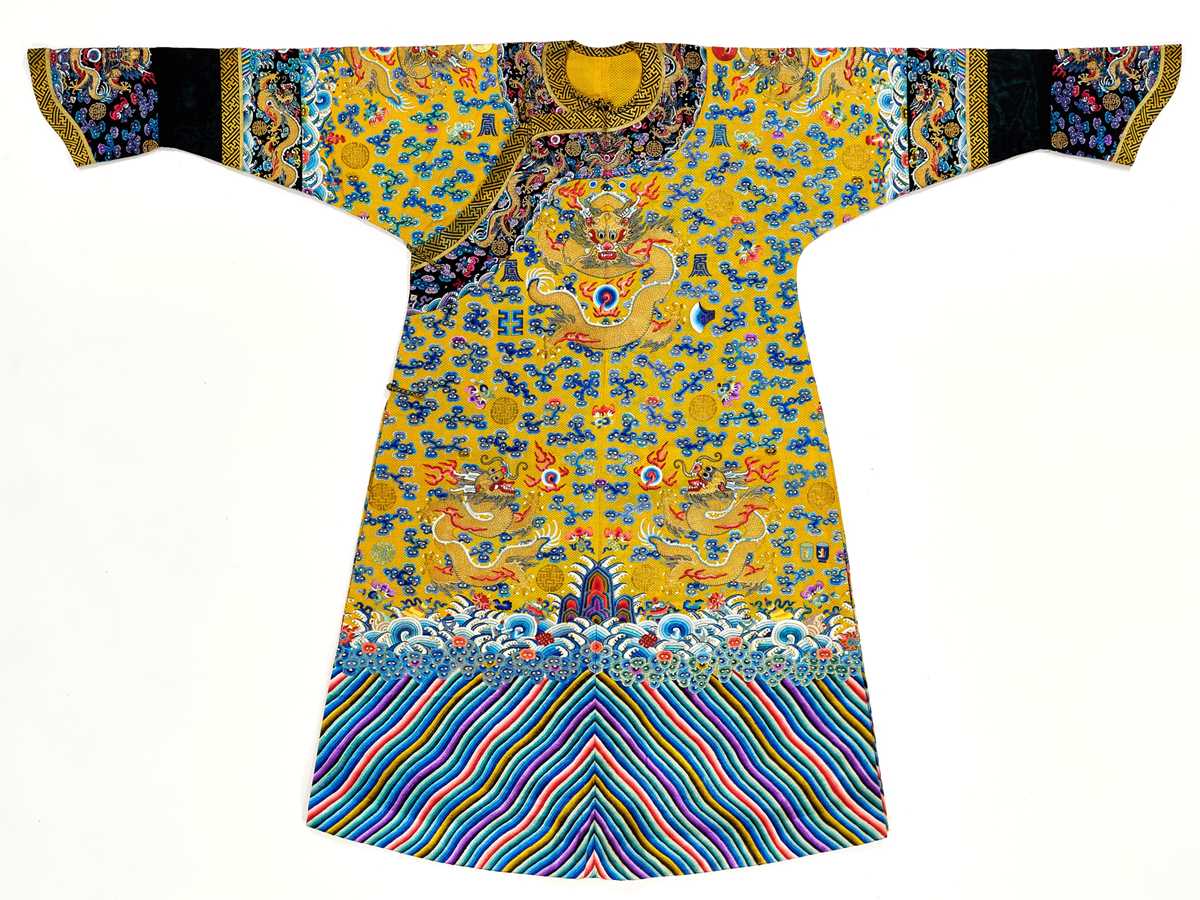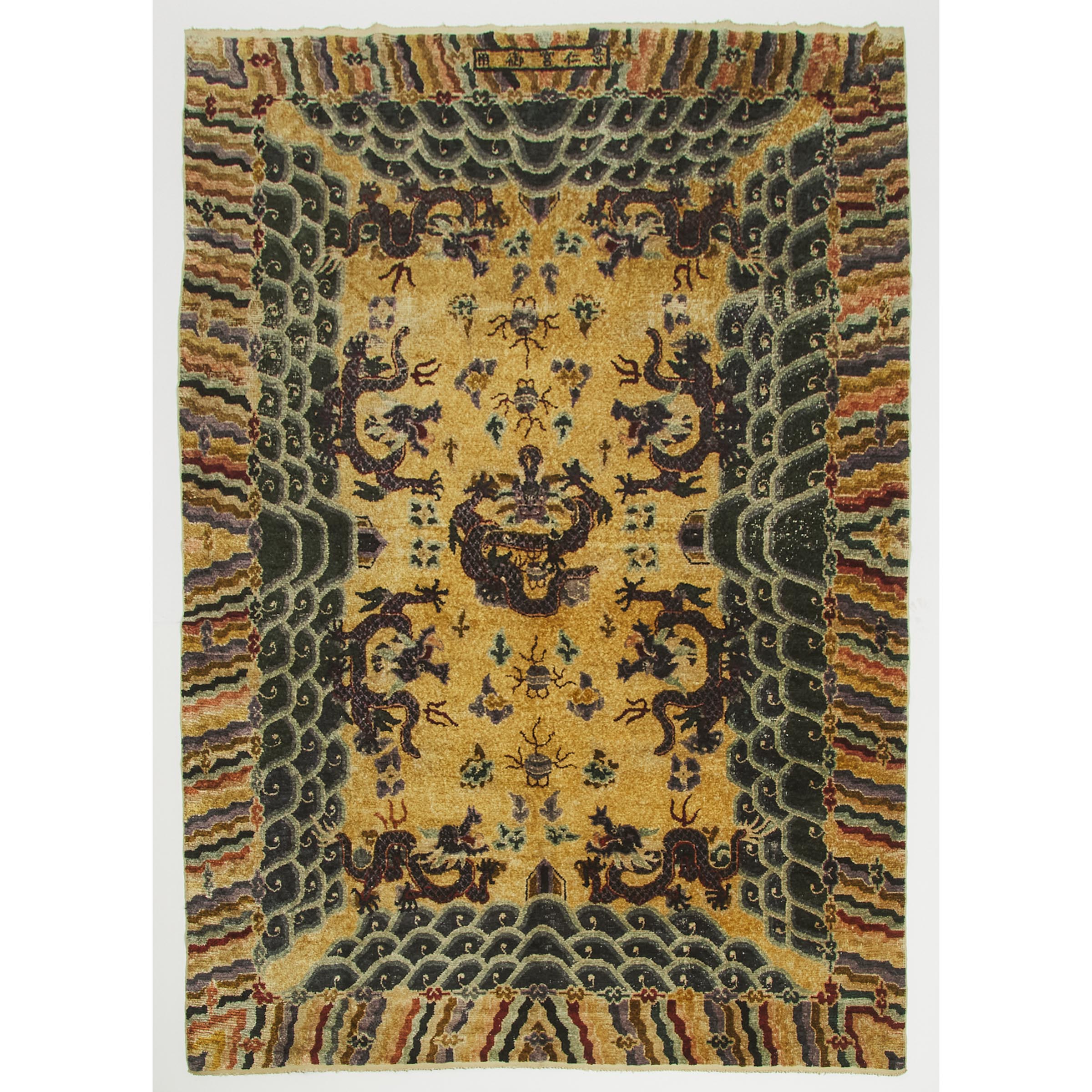AN IMPERIAL YELLOW-GROUND SILK EMBROIDERED 'LOTUS' KANG CUSHION COVER18th/19th century Of rectangular form, delicately worked in shades of red, blue, green, white and purple and gold Peking knot with a central lotus medallion issuing multiple blossoming lotus issuing from curling tendrils and acanthus leaves, all interspersed by the Eight Daoist Emblems, archaistic C designs and butterflies. 200cm (78 6/8in) long x 92cm (36 2/8in) wide.Footnotes十八/十九世紀 黃地打籽繡暗八仙纏枝蓮紋炕罩 Provenance: an Italian private collection, and thence by descent 來源:意大利私人收藏,並由後人保存迄今 Finely embroidered in multi-coloured silk making extensive use of the Pekin knot technique, the present cover is an elegant testament to the scale and opulence of the Qing Court. The cover would have probably lined a large platform within an important hall where the highest-ranking members of the Court sat to rest or entertain. The cover was undoubtedly produced in one of the Imperial workshops wither in Suzhou, Hangzhou or Nanjing. Each of these operations was under the supervision of an administration appointed by the emperor, and was strictly regulated as to the procurement of raw materials, the treatment and pay of the labourers and the shipment of the finished product. The weaving ateliers included technicians and mechanics who maintained the looms, specialists who translated pattern drawings into complex tie-ups required for drawloom weaving, and finally, a large number of weavers who wove the cloth. Needlework was labour-intensive and required technical assistants, pattern-makers and finishers, as well as skilled craftsmen who executed the pieces. The Office of the Imperial Household requisitioned enormous quantities of fabrics from the Imperial silkworks annually. Many of these textiles were used to decorate the several rooms, both in the Forbidden City and in the summer residencies outside Beijing, which required portable furnishings for functions including ritual birthday assemblies, formal audiences with political advisors and private gatherings of family members; see J.Vollmer, Clothed to Rule the Universe. Ming and Qing Dynasty Textiles at the Art Institute of Chigago, washington, 2001, pp.23-25. Compare with a related Imperial yellow-ground silk embroidered seat kang seat cushion cover, early 19th century, decorated with a profusion of blossoming lotus, illustrated by M.Myers, Silks for altars and Thrones, Paris, 2003, p.71, no.32.
AN IMPERIAL YELLOW-GROUND SILK EMBROIDERED 'LOTUS' KANG CUSHION COVER18th/19th century Of rectangular form, delicately worked in shades of red, blue, green, white and purple and gold Peking knot with a central lotus medallion issuing multiple blossoming lotus issuing from curling tendrils and acanthus leaves, all interspersed by the Eight Daoist Emblems, archaistic C designs and butterflies. 200cm (78 6/8in) long x 92cm (36 2/8in) wide.Footnotes十八/十九世紀 黃地打籽繡暗八仙纏枝蓮紋炕罩 Provenance: an Italian private collection, and thence by descent 來源:意大利私人收藏,並由後人保存迄今 Finely embroidered in multi-coloured silk making extensive use of the Pekin knot technique, the present cover is an elegant testament to the scale and opulence of the Qing Court. The cover would have probably lined a large platform within an important hall where the highest-ranking members of the Court sat to rest or entertain. The cover was undoubtedly produced in one of the Imperial workshops wither in Suzhou, Hangzhou or Nanjing. Each of these operations was under the supervision of an administration appointed by the emperor, and was strictly regulated as to the procurement of raw materials, the treatment and pay of the labourers and the shipment of the finished product. The weaving ateliers included technicians and mechanics who maintained the looms, specialists who translated pattern drawings into complex tie-ups required for drawloom weaving, and finally, a large number of weavers who wove the cloth. Needlework was labour-intensive and required technical assistants, pattern-makers and finishers, as well as skilled craftsmen who executed the pieces. The Office of the Imperial Household requisitioned enormous quantities of fabrics from the Imperial silkworks annually. Many of these textiles were used to decorate the several rooms, both in the Forbidden City and in the summer residencies outside Beijing, which required portable furnishings for functions including ritual birthday assemblies, formal audiences with political advisors and private gatherings of family members; see J.Vollmer, Clothed to Rule the Universe. Ming and Qing Dynasty Textiles at the Art Institute of Chigago, washington, 2001, pp.23-25. Compare with a related Imperial yellow-ground silk embroidered seat kang seat cushion cover, early 19th century, decorated with a profusion of blossoming lotus, illustrated by M.Myers, Silks for altars and Thrones, Paris, 2003, p.71, no.32.







.jpg)




Try LotSearch and its premium features for 7 days - without any costs!
Be notified automatically about new items in upcoming auctions.
Create an alert